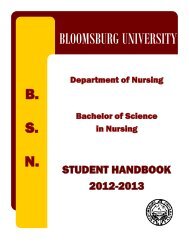Human Rights at Home and Abroad: Past, Present, and Future
Human Rights at Home and Abroad: Past, Present, and Future
Human Rights at Home and Abroad: Past, Present, and Future
You also want an ePaper? Increase the reach of your titles
YUMPU automatically turns print PDFs into web optimized ePapers that Google loves.
―emergency grievance criteria‖, therefore they are denied protective custody <strong>and</strong> remain subject to rape.<br />
In turn, the rapes continue, <strong>and</strong> the victim‘s likelihood of contracting HIV is severely heightened (Arthur,<br />
Davis, Herman)<br />
―In 1997 approxim<strong>at</strong>ely 18,000 inm<strong>at</strong>es were infected with the HIV/AIDS virus, making.<br />
Between 1991 <strong>and</strong> 1993 one in three de<strong>at</strong>hs were <strong>at</strong>tributed to AIDS-rel<strong>at</strong>ed causes, compared to one in<br />
ten outside the penitentiary‖ (Cronan). Making the situ<strong>at</strong>ion worse is the lack of prevent<strong>at</strong>ive measures.<br />
There is close to nothing being done to educ<strong>at</strong>e prisoners of the harsh realities of the spread of<br />
HIV/AIDS. The penal facilities are aware of the abuse going on yet refuse to implement reduction devices<br />
such as condoms, <strong>and</strong> clean needles.<br />
Implementing such devices could help elimin<strong>at</strong>e the virus from within U.S. prisons. If the inm<strong>at</strong>es<br />
were aware of the extent to which the deadly virus is spreading, then maybe they would be less likely to<br />
rape a potential victim. Educ<strong>at</strong>ed people would not knowingly infect themselves with a deadly virus, <strong>and</strong><br />
if condoms were available it would prevent the disease from further spreading. Condoms may or may not<br />
persuade inm<strong>at</strong>es to rape, but if you can‘t prevent the inevitable <strong>at</strong> least you can protect the victims.<br />
Simply adding such prevent<strong>at</strong>ive measure could help decrease the r<strong>at</strong>es of HIV/AIDS rel<strong>at</strong>ed de<strong>at</strong>hs.<br />
Brutal rapes th<strong>at</strong> occur within prison can take their toll on any man, physically <strong>and</strong> mentally. If<br />
the victim is does not contract a disease <strong>and</strong> die from th<strong>at</strong>, or is ―shanked‖ (stabbed) in retali<strong>at</strong>ion for<br />
snitching, then suicide is next on the list. <strong>Human</strong> <strong>Rights</strong> W<strong>at</strong>ch conducted a survey which relayed a<br />
shocking result. The survey showed th<strong>at</strong>, out of the nineteen willing inm<strong>at</strong>es surveyed, all have tried to<br />
commit suicide <strong>and</strong> many more considered it as an option (Mariner, Joanne). Still not accounted for are<br />
the rapes th<strong>at</strong> are not reported. Several inm<strong>at</strong>es are too embarrassed to come forth so the incident never<br />
gets documented. If the situ<strong>at</strong>ion is not addressed the bottled up anger can be a ticking time bomb.<br />
Unfortun<strong>at</strong>ely, <strong>at</strong> the end of th<strong>at</strong> short fuse is suicide.<br />
Suicide ranks third as cause of de<strong>at</strong>h in prison; the origin of the suicides are expected to be caused<br />
by some form of abuse. ―From 1984 to 1993, the r<strong>at</strong>e of prison suicide was more than 50 percent higher<br />
than the n<strong>at</strong>ional average outside of prison‖ (Cronan). Although the d<strong>at</strong>a is old the numbers are still<br />
115
















